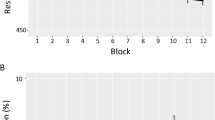Abstract
We investigated the contributions of the sequences of effectors and response locations to probabilistic sequence learning in the serial reaction time task by means of bimanual transfer. Participants, trained with the dominant hand, were either required to maintain responding with the dominant hand after transfer or to switch to the nondominant hand. For both groups, half of the participants were transferred to the originally trained sequence, whereas the other half was transferred to a mirror-ordered sequence. This way, the sequence of effectors varied independently of the sequence of response locations. Sequence learning was assessed with probabilistic sequences, composed of either first-order or second-order probabilities. Transfer of sequence knowledge to the nondominant hand was equally good for the originally trained sequence as for the mirrored sequence. This suggests that probabilistic sequence learning can be based on either the sequence of effectors or response locations. However, when participants responded with the dominant hand to a mirrored sequence, transfer performance was disturbed. This indicates that changing both the sequences of effectors and response locations has a disruptive effect on the learning performance.





Similar content being viewed by others
References
Bapi RS, Doya K, Harner A (1998) Evidence for effector independent and dependent representations and their differential time course of acquisition during motor sequence learning. Exp Brain Res 132:147–162
Cleeremans A, Jimenez L (1998) Implicit sequence learning: the truth is in details. In: Stadler MA, Frensch PA (eds) Handbook of implicit learning. Sage, Thousand Oaks, pp 323–364
Cleeremans A, McClelland JL (1991) Learning the structure of event sequences. J Exp Psychol Gen 120:235–253
Cleeremans A, Destrebecqz A, Boyer M (1998) Implicit learning: news from the front. Trends Cogn Sci 2:406–416
Clegg BA, DiGirolamo GJ, Keele SW (1998) Sequence learning. Trends Cogn Sci 2:275–280
Cohen A, Ivry RI, Keele SW (1990) Attention and structure in sequence learning. J Exp Psychol Learn Mem Cogn 16:17–30
Curran T, Keele SW (1993) Attentional and nonattentional forms of sequence learning. J Exp Psychol Learn Mem Cogn 19:189–202
Deroost N, Soetens E (2005a) Perceptual or motor learning in SRT tasks with complex sequence structures. Psychol Res (in press). DOI 10.1007/s00426-004-0196-3
Deroost N, Soetens E (2005b) Spatial processing and perceptual sequence learning in SRT tasks. Exp Psychol (in press)
Destrebecqz A, Cleeremans A (2001) Can sequence learning be implicit? New evidence with the process dissociation procedure. Psychon Bull Rev 8:343–350
Frensch PA (1998) One concept, multiple meanings. On how to define the concept of implicit learning. In: Stadler MA, Frensch PA (eds) Handbook of implicit learning. Sage, Thousand Oaks, pp 47–104
Frensch PA, Miner CS (1994) Effect of presentation rate and individual differences in short-term memory capacity on an indirect measure of serial learning. Mem Cogn 22:95–110
Frensch PA, Buchner A, Lin J (1994) Implicit learning of unique and ambiguous serial transitions in the presence and absence of a distractor task. J Exp Psychol Learn Mem Cogn 20:567–584
Frensch PA, Lin J, Buchner A (1998) Learning versus behavioral expression of the learned: the effects of a secondary tone-counting task on implicit learning in the serial reaction time task. Psychol Res 61:83–98
Grafton ST, Hazeltine E, Ivry R (2002) Motor sequence learning with the nondominant left hand. Exp Brain Res 146:369–378
Hazeltine E (2002) The representational nature of sequence learning. In: Prinz W, Hommel B (eds) Attention and performance XIX: common mechanisms in perception and action. Oxford University Press, New York, pp 673–689
Heuer H, Schmidtke V (1996) Secondary-task effects on sequence learning. Psychol Res 59:119–133
Hikosaka O, Nakahara H, Rand MK, Sakai K, Lu X, Nakamura K, Miyachi S, Doya K (1999) Parallel neural networks for learning sequential procedures. Trends Neurosci 22:465–471
Japikse KC, Negash S, Howard JH Jr, Howard DV (2003) Intermanual transfer of procedural learning after extended practice of probabilistic sequences. Exp Brain Res 148:38–49
Jimenez L, Mendez C (1999) Which attention is needed for implicit sequence learning? J Exp Psychol Learn Mem Cogn 25:236–259
Jimenez L, Mendez C, Cleeremans A (1996) Comparing direct and indirect measures of sequence learning. J Exp Psychol Learn Mem Cogn 22:948–969
Keele SW, Jennings P, Jones S, Caulton D, Cohen A (1995) On the modularity of sequence representation. J Mot Behav 27:17–30
Kelly SW, Burton AM (2001) Learning complex sequences: no role for observation. Psychol Res 65:15–23
Mayr U (1996) Spatial attention and implicit sequence learning: evidence for independent learning of spatial and nonspatial sequences. J Exp Psychol Learn Mem Cogn 22:350–364
Nattkemper D, Prinz W (1997) Stimulus and response anticipation in a serial reaction task. Psychol Res 60:98–112
Nissen MJ, Bullemer P (1987) Attentional requirements of learning: evidence from performance measures. Cogn Psychol 19:1–32
Park JH, Shea CH (2005) Sequence learning: response structure and effector transfer. Q J Exp Psychol A 58:387–419
Reed J, Johnson P (1994) Assessing implicit learning with indirect tests: determining what is learned about sequence structure. J Exp Psychol Learn Mem Cogn 20:585–594
Remillard G (2003) Pure perceptual-based sequence learning. J Exp Psychol Learn Mem Cogn 29:518–597
Remillard G, Clark JM (2001) Implicit learning of first-, second-, and third-order transition probabilities. J Exp Psychol Learn Mem Cogn 27:483–498
Rüsseler J, Rösler F (2000) Implicit and explicit learning of event sequences: evidence for distinct coding of perceptual and motor responses. Acta Psychol (Amst) 104:45–67
Schneider W, Eschman A, Zuccolotto A (2002) E-prime, Version 1.1. Psychology Software Tools, Pittsburgh
Schvaneveldt R, Gomez RL (1998) Attention and probabilistic sequence learning. Psychol Res 61:175–190
Seger CA (1994) Implicit learning. Psychol Bull 115:163–196
Soetens E, Melis A, Notebaert W (2004) Sequence learning and sequential effects. Psychol Res 69:124–137
Willingham DB, Nissen M, Bullemer P (1989) On the development of procedural knowledge. J Exp Psychol Learn Mem Cogn 15:1047–1060
Willingham DB, Wells LA, Farrell JM, Stemwedel ME (2000) Implicit motor sequence learning is represented in response locations. Mem Cogn 28:366–375
Ziessler M (1998) Response-effect learning as a major component of implicit serial learning. J Exp Psychol Learn Mem Cogn 24:962–978
Ziessler M, Nattkemper D (2001) Learning of event sequences is based on response-effect learning: further evidence from a serial reaction time task. J Exp Psychol Learn Mem Cogn 27:595–613
Acknowledgments
The first author, Natacha Deroost, is Research Assistant of the Research Foundation—Flanders, FWOTM247.
Author information
Authors and Affiliations
Corresponding author
Rights and permissions
About this article
Cite this article
Deroost, N., Zeeuws, I. & Soetens, E. Effector-dependent and response location learning of probabilistic sequences in serial reaction time tasks. Exp Brain Res 171, 469–480 (2006). https://doi.org/10.1007/s00221-005-0294-5
Received:
Accepted:
Published:
Issue Date:
DOI: https://doi.org/10.1007/s00221-005-0294-5




